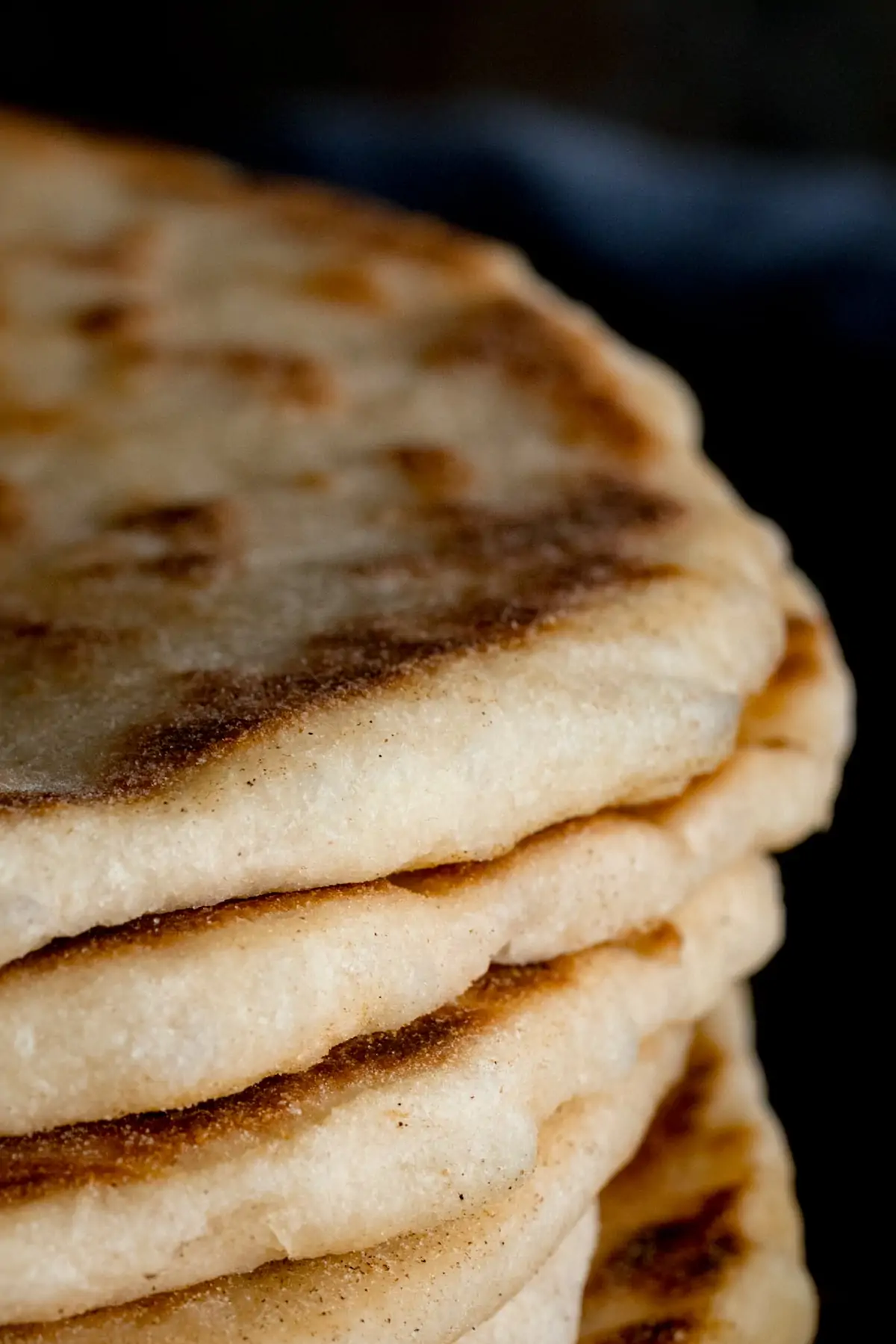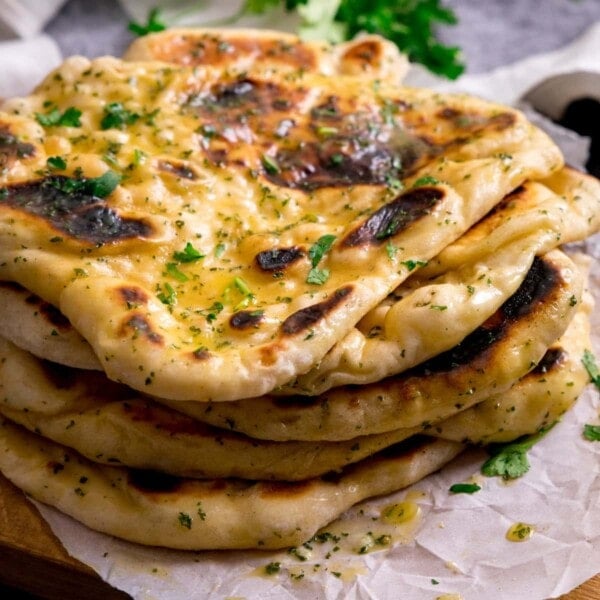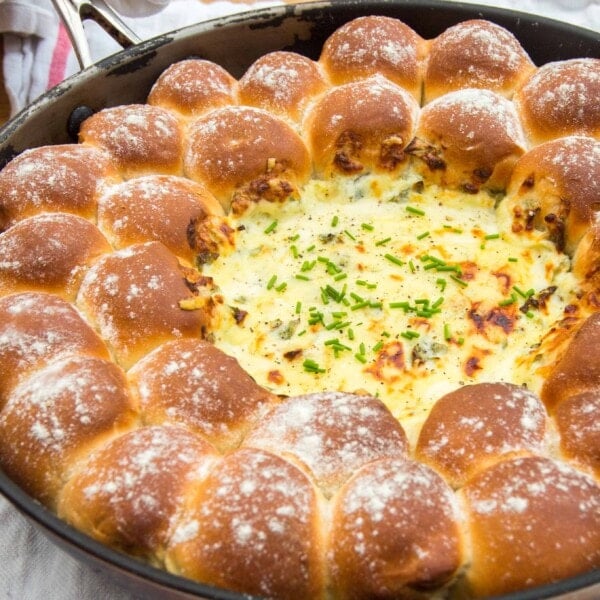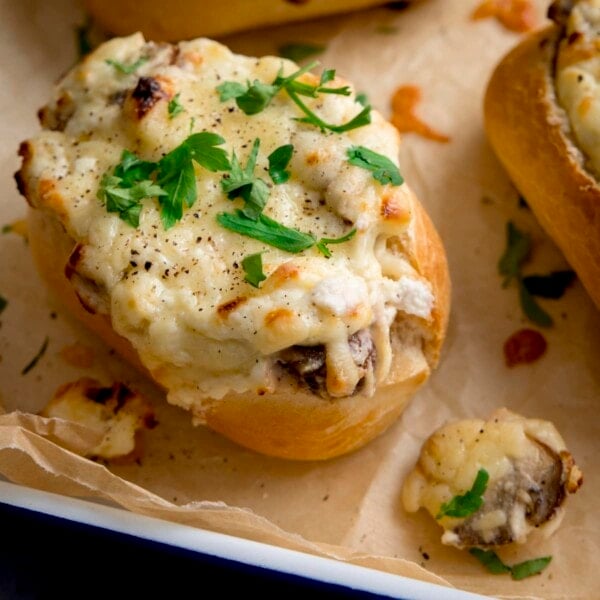Soft, fluffy Greek pita-style flatbreads (the pocketless kind).
I love loading these up to make homemade Gyros or to serve with souvlaki kebabs.
They stay soft and pliable, even when cold, so you can roll or fold them without the risk of them breaking.

Table of Contents
Yes these flatbreads need proving and kneading (use my yogurt flatbread recipe for super-quick flatbreads), but the extra time spent it so worth it. Why?
- You’ll get super fluffy, tender flatbreads with that perfect chewiness – thanks to the yeast and proving.
- They have bags of flavour – again the proving time helps the flavour to develop. The flavour is further enhanced because of the cooking method.
- They taste great hot OR cold.
- They don’t break when you fold them.

Pin this now to find it later
Pin It🔪 How to make them
***Full recipe with detailed steps in the recipe card at the end of this post.***
- Similar to most yeasted bread recipes, we mix together yeast, water, bread flour, sugar and salt. We’re also adding some olive oil to the mixture for extra flavour and tenderness.
- Once they’re mixed, we knead the dough for about 10 minutes, then leave to prove until doubled in size.
- Then we split the dough into 12 pieces, roll each into a ball, and roll out in a flat disk.
- Each flatbread is cooked in a hot, lightly oiled frying pan, until fluffy and golden.
📺 Watch how to make them

👩🍳PRO TIP
These breads are cooked one at a time, but you can keep them warm by stacking them on warm plate under a clean tea towel, or placing on a tray (cover it with foil) and place on a very low oven.
🍽️ What to serve these Greek Pitas with:
Just look at how deliciously fluffy they are inside!

To make ahead, make the pitas, cool them and place on a plate. Cover with foil or clingfilm. They should keep at room temperature for 2 days, or in the fridge for 3-4 days.
Yes they taste great cooked over coals on the BBQ.
If freezing, place in a freezer bag with a piece of baking parchment between each pita (to stop them sticking together). Defrost at room temperate before serving.
Reheating:
The flatbreads can be served at room temperature, or if you want to warm them through, sprinkle with a little water and place in the oven at 180C (350F), on a baking tray (uncovered), in a single layer for 2-3 minutes.
🍞 More fantastic Bread recipes
Stay updated with new recipes!
Subscribe to the newsletter to hear when I post a new recipe. I’m also on YouTube (new videos every week) and Instagram (behind-the-scenes stories & beautiful food photos).

Homemade Flatbread Recipe
Ingredients
- 7 g (2 tsp) instant dry yeast
- 480 ml (2 cups) warm water
- 4 tbsp olive oil plus extra for brushing (approx 2-3 tbsp)
- 780 g (6 ½) cups strong bread flour plus extra for rolling (approx 60g or 1/2 cup)
- 1 ½ tsp sugar
- 1 ½ tsp table salt
Instructions
- Place the yeast in the bowl of a stand mixer (or a large bowl) and add the warm water. Stir together and leave for 5 minutes, until foam appears on top of the water.7 g (2 tsp) instant dry yeast, 480 ml (2 cups) warm water
- Add the olive oil, flour, sugar, and salt to the yeast mixture.4 tbsp olive oil, 780 g (6 ½) cups strong bread flour, 1 ½ tsp sugar, 1 ½ tsp table salt
- Mix the dough together using either using a stand mixer with a dough hook (recommended) or your hands, until combined.
- Once combined, knead the dough for 10 minutes using the stand mixer with a dough hook or by hand. The mixture will be quite sticky, so if you’re kneading by hand, it’s a good idea to coat your hands and work surface in a little olive oil to stop it sticking.
- Place the dough in an oiled bowl, cover with a damp cloth or clingfilm and allow to prove for 60-90 minutes, until doubled in size.
- Lightly flour the work surface.
- Divide the dough into 12 equal pieces. If you want to take your time you can shape into balls and place on a tray or board with a damp cloth over the top to rest for a few minutes, while you prepare to start cooking them.
- Take one of the dough balls, and roll it into a flatbread shape, about 19cm (7.5 inches) in diameter and ½ cm (just under ¼ inch) thick.
- Brush or spray a medium-sized frying pan (cast iron gives you the best results) with a little oil (just 1/4 tsp or so) and place over a medium-high heat to heat up.
- Toss the pita back and forth a couple of times in your hands to remove excess flour, then place the pita in the pan.
- Cook for about 60-90 seconds, until bubbles start to appear. Then turn over a cook for a further minute. Whilst that's cooking roll our the next flatbread.
- Place on a plate, cover with a clean tea towel and then repeat, brushing the pan with oil after every 3 or 4 pitas.
- Stack the flatbreads on the plate (stacking them helps to keep them soft), laying a tea towel over them to keep warm until you’re ready to serve.
Video
Notes
Make Ahead
To make ahead, make the pitas, cool them and place on a plate. Cover with foil or clingfilm. They should keep at room temperature for 2 days, or in the fridge for 3-4 days.Freezing
If freezing, place in a freezer bag with a piece of baking parchment between each pita (to stop them sticking together). Defrost at room temperate before serving.Reheating:
The flatbreads can be served at room temperature, or if you want to warm them through, sprinkle with a little water and place in the oven at 180C (350F), on a baking tray (uncovered), in a single layer for 2-3 minutes. Nutritional information is approximate and is per flatbread.Nutrition
Nutrition information is automatically calculated, so should only be used as an approximation.
This post was first published in July 2021 and has been updated with a video, FAQ’s and for housekeeping reasons in August 2024.
Some of the links in this post may be affiliate links – which means if you buy the product I get a small commission (at no extra cost to you). If you do buy, then thank you! That’s what helps us to keep Kitchen Sanctuary running. The nutritional information provided is approximate and can vary depending on several factors. For more information please see our Terms & Conditions.































This is my go to flatbread recipe now. It’s fantastic and gets consistently good results. I sometimes sub out some of the flour for wholemeal, and also half the water for milk to make them even softer. They bake well in a gas-fired pizza oven, as well as in the pan.
Not sure why but my dough was dry, like very dry. Not sticky at all. My flatbreads also turned out dense and bland 🙁 I’m sure yall have had great results from this recipe but idk why I did wrong. I followed the recipe and used the exact measurements. Idk I just wanted to say that the dough was dry in case anyone else has the same issue.
Wow, I’ve been looking for a soft dairy free flatbread recipe for a while, this is the one! I will never use another flatbread recipe again!
I made 1/2 the recipe and used my breadmaker to knead and rise the dough
These flatbreads are truly amazing, certainly the best I’ve made and so much nicer than many shop bought breads. Thank you so much for the recipe with the very clear detailed instructions. I’m hosting Easter and these will definitely be on the menu
Wonderful recipe!
I’ve been trying to make my own rolls and they always end up being hard.
Your flatbread is so easy to slice and fill with all kinds of yummy things. We had them made into cheeseburgers tonight.
An amazing recipe. My first try turned out wonderfully. Now I do it once a week. I have a breakmaker so I put all the ingredients – after following your first step for yeast dissolving and foam to appear on top of the water – in the bread pan and turn on the pizza setting for 20 minutes for the machine to do all the kneading, then I have a nice dough out to work on. Thanks so much.
If I have no olive oil could I use sun flower or rapeseed oil?
Can you let the dough stand in fridge, roll and fry the next day?